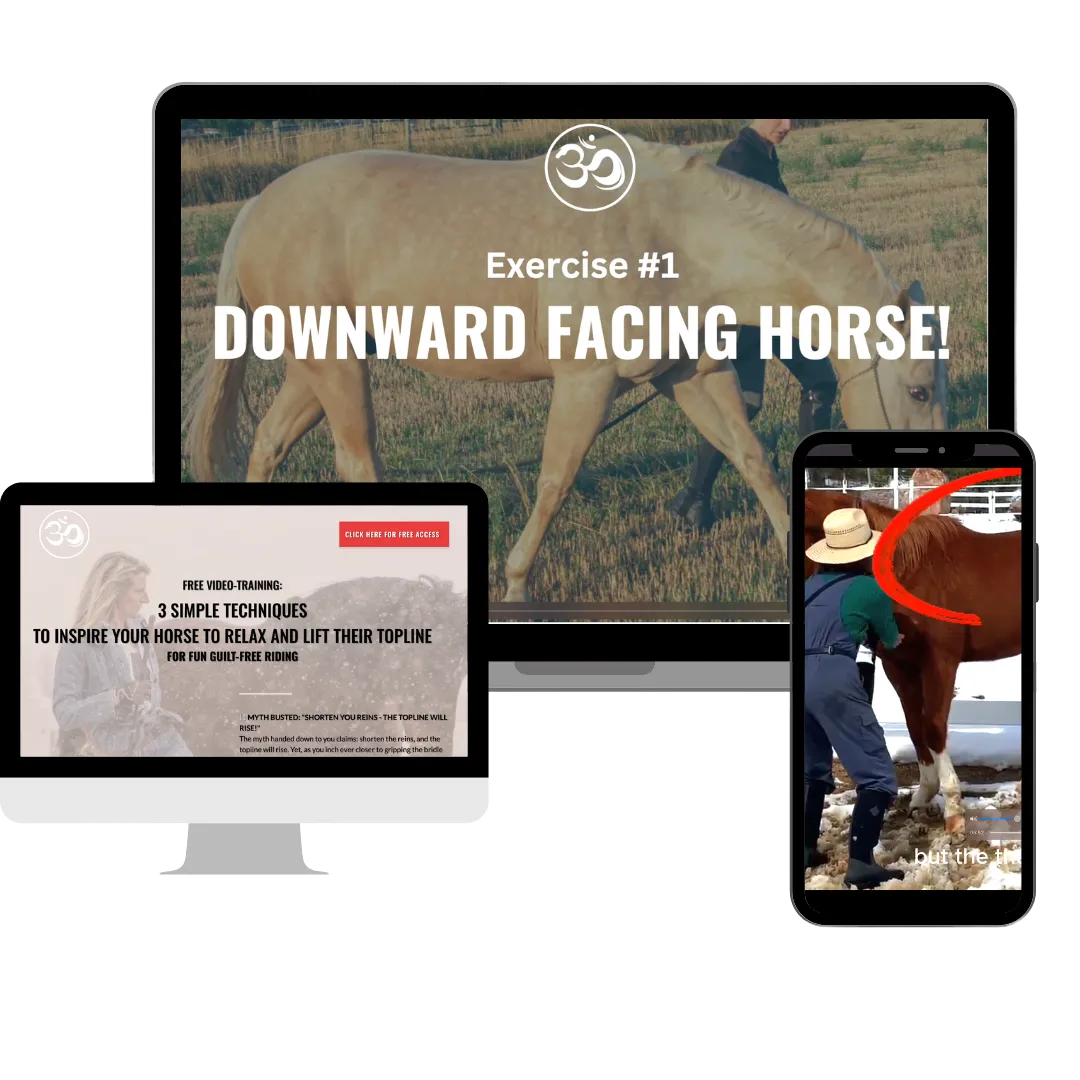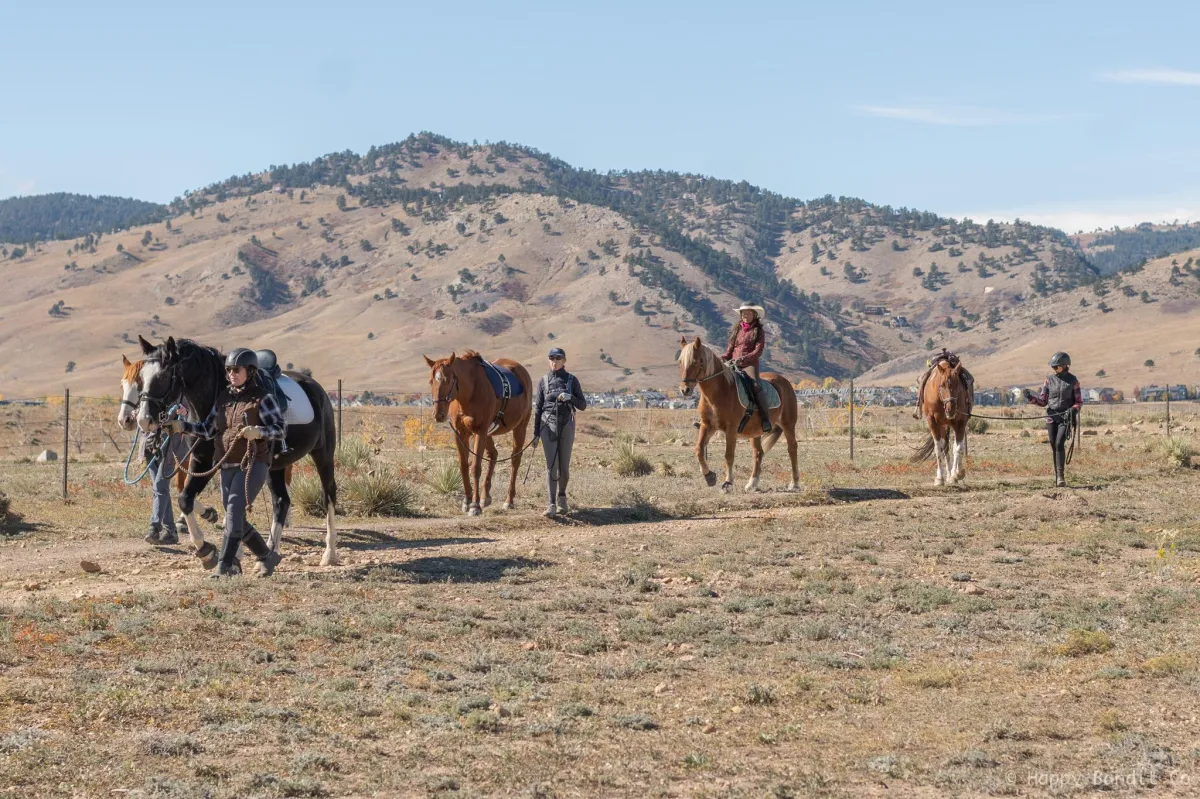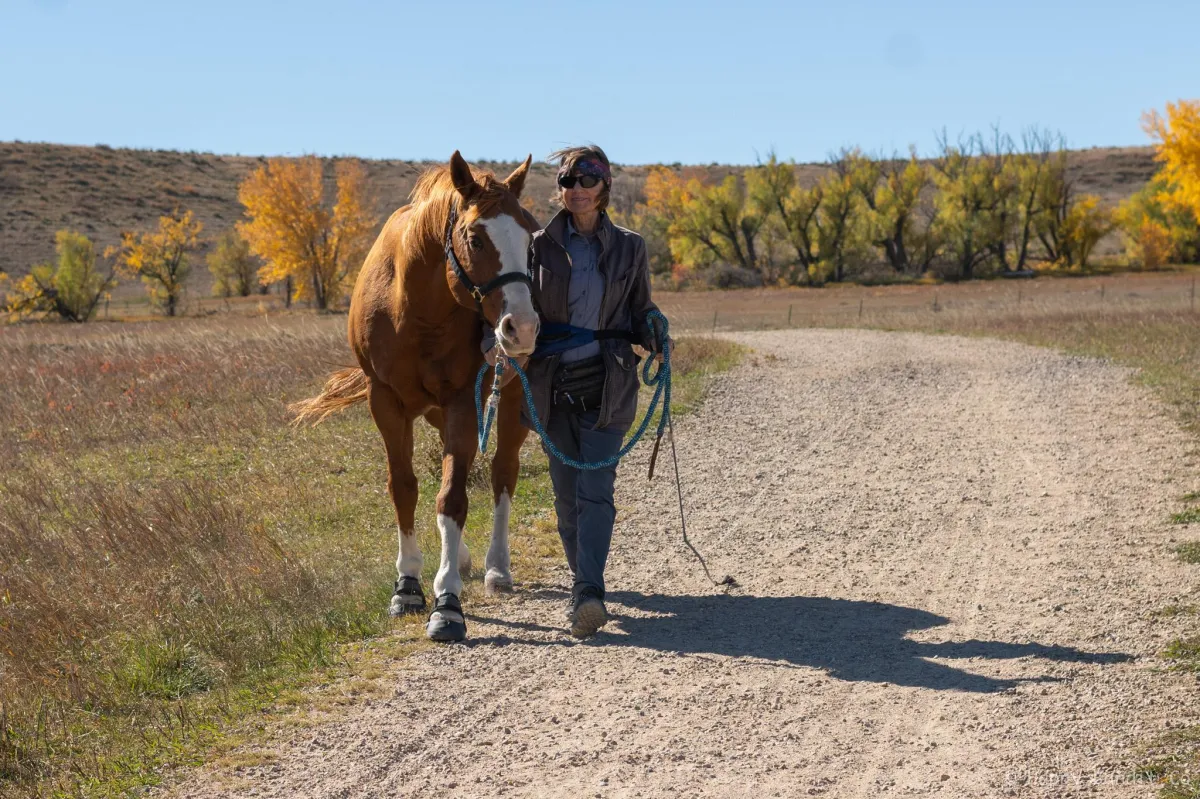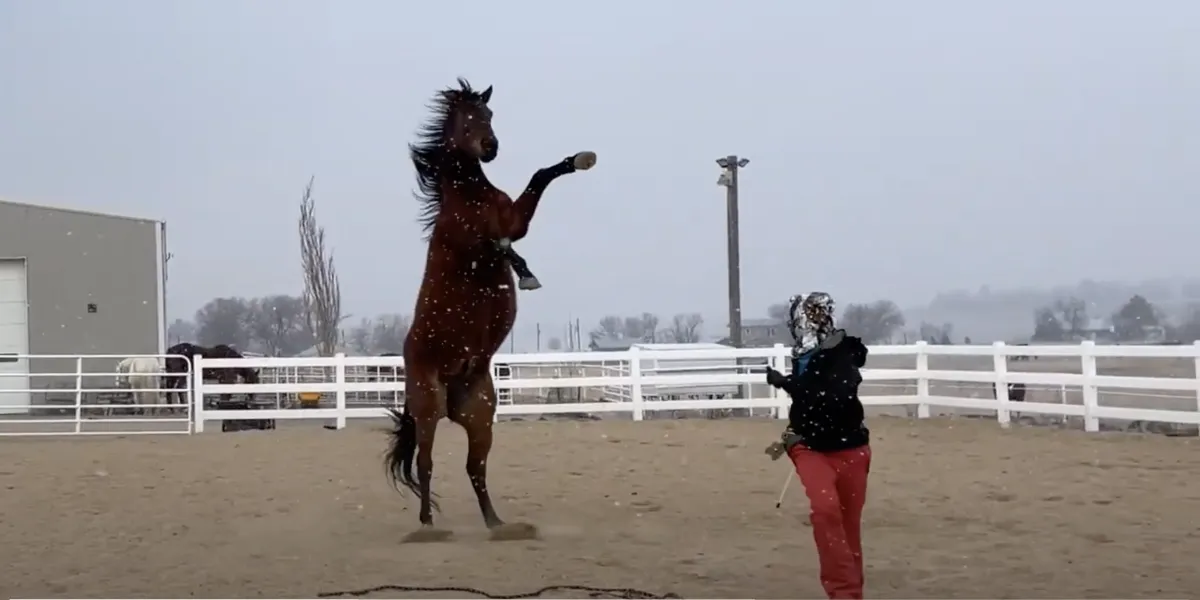HI! LET US DIRECT YOU TO WHERE YOU'D LIKE TO GO 🤗
LOCAL PROGRAMS
AT WILDSONG RANCH IN LONGMONT, COLORADO
CLINICS AND RETREATS
ONLINE TRAINING
ITALIA
HI! LET US DIRECT YOU TO WHERE YOU'D LIKE TO GO 🤗
LOCAL PROGRAMS
AT WILDSONG RANCH IN LONGMONT,
COLORADO
CLINICS AND RETREATS
ONLINE TRAINING
ITALIA
Attention Heart-felt Horse Owners!
Empower your horse-human relationship with that sacred oneness you only thought existed in Movies!
We support horses and their humans to feel amazing in their bodies, minds and spirits through play, consent, confident horsemanship, and science.
We know how it feels to have a horse who is unhappy with life...or with you
Your horse is supposed to love it, yet...
Your horse has a stunning hiney...BUT YOU'RE SO TIRED OF STARING AT IT!!!
You are doing everything right and everyone tells you your horse should love playing at liberty with you...but despite all the money and time spent in clinics, lessons and courses, as soon as halter and lead rope are off, she runs away from you to a spot where she can focus on anything but you.
Are you fed up with Dr. Google?
Your horse will pin his ears (or often try to bite you) when he is approached at the rib cage, touched at the pole and especially when tacked up. You've been told he's disrespectful, lazy, dominant, and you need to show him who's boss.
You don't know about this boss thing, and neither does your horse 🤔.
You have started to search online for what else you might be missing - maybe this horse is in pain? - but it's a jungle out there and you are more confused than ever.
When it comes to it, you actually don't trust your horse. Or yourself.
Bridleless looks so cool...but it's surely not for you. Your horse is not trustworthy enough to stop or listen (or he is actively looking for a way to dislodge you), and you aren't anywhere close to taking out the bit, let alone removing the bridle. Also, you feel like your body is clumsy, uncoordinated, unbalanced. How are you ever going to pull this off?
You are actually ashamed
Your horse is shut down, disconnected, unsafe, robotic. She either doesn't move or she full on explodes. The methods you are using only seem to be making those extremes more extreme.
And if you are honest with yourself, the methods you are using bring out the worst in you. You don't like yourself.
The only way it seems that you can enjoy yourself around your horse is when you are just asking nothing of her, and ugh...why even have a horse?
ARe you afraid of...
...being too sensitive and empathic to train horses?
...being hurt by your horse (or one you have in training)?
...being the black sheep at your barn (even though it's a horse facility 🤪) and feeling judged all the time?
...becoming Mr Hyde. Is that whole dominance/disrespect/show them who's boss thing starting to feel icky? Is that truly the only way?
...doing something wrong and ruining your horse?
...your horse not enjoying their time with you? Not wanting to be a part of your goals?
...competing?
...literally going around in circles at walk, trot, canter, walk, trot canter rinse repeat like groundhog's day?
...going on that Sunday trail ride and not coming back in one piece...or worse...not being asked to go anymore by the friends who have been hearing the same excuses you have been making for years?
...your dreams being further and further out of reach that you are considering giving it all up and focusing your energies on learning guitar, knitting, bridge...or anything that doesn't involve an animate partner?
...yet another disappointment from a new-to-you horsemanship framework that's supposed to help...but it really doesn't?
Imagine...
...being EXACTLY who you need to be to train horses - and more than that...you are a badass for it!
...having unshakeable confidence in your decision-making & skillful implementation: training, management, care, choosing professionals who are right for you...you are scientifically (like, peer-reviewed!) informed and you are not at the mercy of the decisions and instructions of a trainer (or your boss, or your mentor) anymore.
...serious fun/authentic joy being the new normal while playing with your horse. Hakuna matata!
...fulfilling your dreams, and having a horse who wants to join you on the journey 100% of the way.
...allowing yourself to prioritize your relationship with your horse and STILL doing amazing at shows!
...co-creating magical liberty & trick training routines with your horse!
...riding dressage without a bit or a bridle, doing obstacles, jumping, and feeling like you have that Olympic winning ride each time!
...hopping in and out of that trailer no big deal and being the most confident pair on that Sunday trail ride.
...your movie-like deliciously sappy and badass dreams with your horse are your new normal.
THIS IS HOW WE HELP YOU FIND THE MAGIC...
1. MInd
KNOWLEDGEABLE
We teach you the science and an eclectic, all-encompassing horsemanship repertoire. We advise you on how and when to use them.
SAFE
We give you the tools to establish safe boundaries with your horse in a fair and ethical way, utilizing natural horsemanship (Pressure and Release) with compassion and feel.
INTERESTING
We give you tools to make your horse feel mentally stimulated and engaged in your activities together.
PLEASANT
We teach about Positive Reinforcement (with treats or without...but either way...always positive)!
ASPIRE
You will learn to love learning!
3. Emotions
TRUST
You will learn about two-way communication and consent. We make sure you know how to help your horse feel seen, heard, and understood.
AWARE
We create a safe environment where you can learn about yourself in relationship to your horse, and give yourself permission to let go of limiting beliefs.
FUN
Safety is not a problem anymore, so your new word is FUN! We inspire you with an infinite repertoire of tricks, routines, patterns, activities for your play sessions and down time together.
RELIEF
We give you tools to RELAX. Both of you, equine and human. Mindfulness...together!
And yes, even your horse can get there, we promise.
2. Body
FREE
We give you guidance on how to help your horse explore healthy movement in a way that helps him or her feel alive and free.
ATHLETIC
We utilize the latest movement science and Intrinzen principles to maximize your horse's and your athletic potential!
CUSTOM
We help EVERY horse body and EVERY human body because conformation is not destiny. YES! EVEN YOU!
BALANCE
We help you (and your horse!) feel balanced, loose and capable in the saddle and on the ground. You both will come to trust your body and develop ease within any riding discipline or horsemanship task.
4. Spirit
FULFILLING
We help you design your dreams. We help you remember what it was that made you fall in love with horses to begin with. We encourage you to ask yourself what goals with horses came out of that love. We ask you to envision yourself actually fulfilling those dreams.
PASSION
We also ask you to find out from your horse what he or she wants to be when they grow up! We find what they are passionate about and use their interests as motivation.
TOGETHER
We help you marry your dreams with your horse's so you both walk the same path together! Like horse-human couples' therapists. 😍🐴
OMG Your horse has never moved like THIS before!
Holy bananas! you are actually having fun?
Wait...what? your horse REALLY invited you to hop on?!?
Hey (previously CONSIDERED) weirdo... YOu are now a trendsetter!
start here
LOCAL PROGRAMS (AT WILDSONG RANCH IN LONGMONT, COLORADO)
CLINICS AND RETREATS
ONLINE TRAINING
ACCESS our
free VIDEO-TRAINING!
"3 SIMPLE TECHNIQUES
TO INSPIRE YOUR HORSE TO RELAX AND LIFT THEIR TOPLINE
FOR FUN GUILT-FREE RIDING"
Your horse constantly slips out from under you like a bar of wet soap.
You've tried everything, yet when your horse does manage to lift their topline, it's a "fake" lift. It's tense, it's unrideable. It feels like a pogo stick ride.
Every whoa feels like a Herculean tug-of-war and it might or might not happen five slogged-through-mud-like steps later
Your horse had a long break and you're eager to ride again...but all the topline enhancing techniques you know take forever. Someone please buy me a magic wand!!

WHATEVER THE STARTING POINT...
...Your own version of riding off into the sunset exists!
Even with bolting horses, "actively-trying-to-kill-you" horses, "what-does-personal-space-even-mean" horses, bored-to-death horses, "all-broken-up-from-previous-career" horses, wild-and-traumatized horses or completely-shut-down horses.
Even if you had a hip replacement, even if you are considered the snowflake weirdo nerd at your barn, even if you approach horses at a later age, even if you are a highly sensitive person.
You got this!
TESTIMONIALS

\
"Elizabeth and Giorgia are exceptional horse trainers who focus on the well being, as well as dressage training of horses. No matter what level of training your horse is at when (s)he arrives, whether a young one or upper level, introducing Intrinzen, positive reinforcement and other training methodologies, your horse is in excellent hands!
Thanks to both of you for my horse’s all around emotional, mental and physical training!"

Magdalene Canyon
Horse mom, Professional Dancer

"If you want deep relevant connection for yourself and your horse, then train with Hatha Equus. These three talented women really know horses and humans and can bring out the best in both. I first was drawn to Hatha Equus training program when traditional training did not fit me and my horse friend. I had dabbled in R+ and found it to be lots of fun. R+was the hook. Never did I guess that was just the tip of what Hatha Equus offers. Safety, Riding, Tailer loading, Dressage, Intrinzen, Consent, and problem solving are just some of the other offerings. I sincerely believe they can help anyone with any training needs and and you will feel so very connected"

Sue Garcia
Horse Owner

"The Positive Reinforcement training I took with Hatha Equus was not only an exciting new way to connect with my horse but was also helpful to my overall horsemanship journey. Giorgia's knowledge of how to read and connect with my horse, helped me break through barriers I had not only put on my horse but also on myself. It was through this training that I started to understand the spiritual connection I can have with these incredible and intelligent animals. While all at the same keeping safety for me and my horse in mind. Highly recommended no matter where you are in your own horsemanship journey".

Sydney Thomas
Equestrian, Nature Guide


